“Evidence of the power and effect of jokes can be seen in the fact that dictators and totalitarian regimes – and occasionally also thin-skinned politicians in democracies – fear them like the plague.” – Paul Watzlawick
As is so often true on our planet, it’s best to begin with a story.
The heart of Acoma is Sky City, entrenched on a beige and red rock mesa 360 feet above a broad flat, fronted by three hoodoo-like rock formations as you approach it from the north. While the Acomas believe they’ve always lived on that mesa, an archaeological hypothesis is that it was settled in the 12th or 13th century by ancestral Pueblo Indians from Mogollon, Chaco-Mesa Verde, and elsewhere; that it was a prime defensive site, complete with natural rock cisterns, chosen during an era of societal collapse, periodic violence, and mass migration.
I bought a ticket at the visitor’s center and went up on the mesa in a small bus with our obliging Acoma guide. The mesa top is replete with ancient, humble adobe structures – dwellings and kivas – but our guide took us inside the big old church first. With its twin towers and its bell that was shipped across the waters by a Spanish king, it dwarfs all other structures on the mesa. Standing outside staring up at the church’s facade, standing inside with our little group and our guide, it emitted this message: submit and obey.
Here is how the Spaniards first communicated their message of domination to the Acomas, per Alfonso Ortiz, who was both a Tewa Pueblo Indian and an anthropologist (cool, yes?): “In 1599, the Indians defied Spanish soldiers who attempted to take provisions by force at the pueblo of Acoma: in the ensuing battle, hundreds of Indians and 11 Spaniards were killed. Two Franciscans who witnessed the incident at Acoma later testified to a commission of inquiry about various atrocities perpetuated there by their countrymen, including burning women and children alive.
“Those Acoma residents who survived the massacre were dealt with severely, as a message from the Spanish to the other pueblos. Males over 25 years of age were sentenced to have one foot cut off and endure 20 years of personal servitude. Women over 12 years of age were sentenced to 20 years of servitude, and children under the age of 12 were placed in the care of either friars or colonists in order to be brought up as Christians and servants to the Spaniards.” (The Pueblo, 1994, pp. 40-41). While the then commandant of the Spanish in New Mexico, Don Juan de Onate, was later recalled and punished for his brutality, his forces had already delivered the message of stark domination.
***
In my day job I work as a mental health counselor (as if we know what mental health is). One of the things some of us do know is that utilizing a reversal (a “180 degree opposite”) is often an effective way to help a person who is in a relationship conflict. To accomplish a reversal, assuming the conditions are right, you obtain a description of exactly what the person is saying and doing in order to resolve the conflict – their attempted solution – and then give them a task assignment to do precisely the opposite. It usually works if you know what you’re doing, and it can be magically effective (please don’t try this on your own at home, kids).
Utilizing a lot of reversals creates a kind of echo chamber of humor. Paul Watzlawick, who was instrumental in discovering how to use them in counseling, said: “people who suffer from emotional problems are half over them once they manage to laugh at their predicament.” (The Language of Change, 1978, p. 56.) Exactly.
Most if not all humor is in fact based on reversals. The straight line in a joke, which is the real key, sets up a certain expectation in the audience and the punch line goes in the opposite direction or at least in an unexpected direction. Do enough reversals and you’ll start hunting for good straight lines through the day. Seek and ye shall find!
***
Ironically, the Acomas see the church building on their mesa as “sacred in ways similar to their kivas.” (See Ward Alan Minge, Acoma: Pueblo in the Sky, 2d Edition, 1991, p. 167). One reason they regard this church so highly is that a compassionate Franciscan, Fray Juan Ramirez, who served at Acoma for many years beginning in 1629, helped them rebuild their mesa top village after the Spaniards had burned it. (See pp. 20-21.) Part of this endeavor was building that church. In any case, “Acomas hold him in great respect and some even endow him with saintly virtues.” (p. 20). He must have been a helluva guy.
I suspect another reason for regarding this church as similar to their kivas, however, is that it may have been built on top of an pre-existing Acoma sacred site: atop a great kiva, a shrine, or a ritual site. If that’s the case it may be the underlying ground that’s sacred to the Acomas more than the adobe structure on top of it.
There was another, pragmatic reason for lending esteem to the church building. By 1700 it must have become clear across the Pueblos that the Spanish were technologically advanced but spiritually obtuse invaders who were bent on subduing them and willing if not eager to exploit them. Better to appear religiously compliant as a protection.
While there must have been compassionate friars among the Pueblos akin to Fray Ramirez, the workaday outlook most of them had was something else. As Ortiz says, “The friars were generally humorless and unrelenting disciplinarians with little understanding or tolerance of native tradition. For the slightest offenses – failure to attend mass, for example – Indians had their heads shaved, were whipped, or were detained in stocks.” (p. 47). No surprise then that hundreds of years later our Acoma tour guide, hugging his elbows to his chest inside the high-roofed church, said to us, “We Acomas accept Catholicism, but we do not embrace it.”
***
Paul Watzlawick also said, “In its sovereign disdain for the bounds of logic and rationality, the joke can explode world images and thus become the agent of change…jokes have a disrespectful ability to make light of seemingly monolithic world orders and images” (p.55). Nothing helps people in emotional distress more, assuming the timing’s right, than seeing what’s absurd. Once the blowtorch of humor has cut through the bullshit, once they start to laugh, they’re much less likely to be impressed by another pile of it.
Which is a bad outcome for purveyors of propaganda because their power, even their wealth, depends on people taking their bullshit seriously. That’s true whether it’s used to maintain a single abusive relationship or a financial aristocracy (cf. the boys and girls at Fox News) or a dictatorship like Communist China (isn’t the way they treat their dissidents special). While propagandists will readily mock and laugh at people they see as a threat, and may sprinkle a few jokes to relieve tension, they avoid the focused utilization of humor to garner insight. In fact they suppress such humor if they can, the supreme example being Nazi Germany: “The Gestapo had its own joke department…whose task it was to trace the originators of political jokes. After all, jokes are political dynamite whose production and possession was (and in many parts of the world still is) strictly forbidden.” (Watzlawick, pp. 54.)
***
The Pueblo Indians must have been angered, and later amused, by the inability of the friars to comprehend how absurd their expectations for sincere conversions were. Not that the Catholic Christianity they were preaching was necessarily untrue. Even though the Indians must have found its tenets bizarre at first, they probably sensed that the religion was transforming for some. What must have seemed ominous and weird to them was that the friars saw no irony in hounding them to become Christian believers while consigning them to a life of servitude to the Spaniards.
The friars couldn’t see that this was nuts.
The Indians’ ancestors had encountered this before, minus the canons and gunpowder. In the 12th and 13th centuries the ancestral Pueblo Indians in northwestern New Mexico and southwestern Colorado had lived through the violent collapse of a society ruled by their own presumptuous elites, likely followed by internecine warfare in at least the Mesa Verde area. Of course innumerable human societies have lived through this sort of thing without learning very much, but the ancestral Pueblo did. Through the fourteenth century they reverse engineered their intricate religious traditions and rituals so as to block dominant hierarchies from arising again. They became experts at this.
It was obvious to them that the Spanish were clueless.
***
And it so happens that Pueblo Indian rituals and traditions are pervaded by reversals. The difference, as far as I can tell, is that the Pueblos have been utilizing them for 700 years whereas Western culture acquired a serious understanding of the phenomenon maybe 50 years ago. Note the following from Alfonso Ortiz’s seminal anthropological study, The Tewa World, published in 1969, which focuses on his native Ohkay Owingeh Pueblo: “the Tewa are given to reversals or symbolic transformations…they do it with colors, as when, in some rituals, the colors for north and south are reversed. They also sometimes do it with ideas and institutions they share with neighboring tribes. For instance, among the Keresans of Cochiti [Acoma is also Keresan] the two sacred clown societies, Quirana and Koshare, are associated with summer and winter respectively…while among the Tewa the analogous Kwirana and Kossa are symbolically associated with winter and summer respectively…the Tewa seem to shift easily from one perspective (or transformation) to another in accordance with some consistent set of rules.” (pp. 143-144).
This description rings true. In order to utilize reversals in counseling, following a consistent set of rules is essential and learning how to do that takes a great deal of focus, patience and care. It’s fair to say that accomplishing these astonishing transformations is a ritualistic process. And once those rules become ingrained and a person begins to follow them spontaneously, the echo chamber of humor begins to resound.
In our culture people think that humor can’t be learned from scratch; that it’s some mysterious gift selected people have. This is not true. The rules can indeed be learned in an electrifyingly effective way, just as the Pueblo Indians have learned them from childhood in their ritual dances and traditions. In this I suspect they remain far ahead of the rest of us.
***
After our adventure inside the high solemn space of the church, our guide led us into the heart of the village. Where the kivas are.
There were several in a row along one of the wide dirt streets, each inside a small, square adobe structure. A traditional, white-painted wooden entrance ladder leaned up against each kiva, each one made of two huge tree trunks with thin wooden rungs strung between them up as far as the roof. So that nearly half the lengths of the tree trunks reached above the roofs, making the ladders seem as much symbolic as functional.
The kivas are sacred Acoma spaces dug well into the ground; each features an entrance to a spiritual world beneath the center of its floor space.
Outsiders are not welcome inside kivas.
***
Compared to other places in our solar system, American culture does a tolerable job of accommodating humor. This is because the First Amendment to the United States Constitution forbids the government from dragging a person off to jail because some prominent fart has an issue with satire. Able comedians have long had the leeway to puncture political gas, flattening nascent demagogues along the way.
The First Amendment is a sacred tradition.
But have you noticed that our sharpest comedians are virtually silent on global warming? Why is that? Consider the recent 30 second television ad touting the mining of tar sands, the one with the professionally clad blonde lady striding across the screen, issued by the American Petroleum Institute (“One Million New Jobs”). People who comprehend what climate scientist James Hansen says about tar sands are astonished by the callousness this ad shows toward the well-being of future generations and other species on this Earth. My point is that our best and brightest comedians have material for withering satire pouring out of their noses. And the Lord knows there has never been a greater need.
So why are these comedians holding back? Either because they’re waiting for a receptive audience or because they’re nervous about pissing off the mainstream Colossus or both. In other words, their personal interests are causing them to hesitate in the face of lethal propaganda. This is a clear indication that the First Amendment notwithstanding, in American culture humor is not a sacred task.
The opposite is the case in Pueblo cultures. On page 81 of his book The Tewa World, Alfonso Ortiz laid out a riveting diagram of the eight sacred societies of the Ohkay Owingeh Tewas. Their two clown societies, the Kwirana and Kossa, are near the center of the whole structure. There’s no mistaking the message. Their job, along with the other societies, is to keep the heart of their society beating.
Per Ortiz, the sacred societies of this pueblo have these priorities: first, to keep the seasons progressing normally (cf. the effects of global warming), second, peace and harmony in social relations (our political parties can’t agree on how to take a shit), and third, to prevent any faction of their society from attaining ritual or political supremacy (in the meantime our financial aristocracy rules). (See pp. 73, 84).
It’s a sacred task to protect the capacity of the people to see through bullshit. As a culture we’re not doing that, and it’s one reason the privileged interests in our country have been able to befuddle the public into ignoring the climate catastrophe that is descending upon our children and grandchildren.
***
I went back to Acoma some years later for a repeat of the tour, this time with Gail. The tribe had remodeled the old visitor’s center, which lies in the cusp of a ridge of rough rocks beneath the mesa. The new center featured handsome stone wall motifs and “T” shaped doorways found in Sky City and also in ancestral pueblo ruins.
Up on the mesa Gary, our Acoma guide, said to us with a nod, “We’ll be here a thousand years from now. Our Elders have a good plan.” I was struck by his conviction that the Acoma elders were looking out for the interests of their people over the long term. I hadn’t felt that way since President Carter talked up the energy crisis in the late 1970s. Tragically, most Americans found his bluntness unsettling, as he hadn’t bothered to sprinkle any bullshit in with it.
After the tour Gail and I ate lunch in the new restaurant, which served artfully prepared Acoma dishes. Looking up at the lovely stone walls, I had the feeling Gary was right about the future of the Acomas.
Scott Thompson is a regular contributor to the Zephyr. He lives in West Virginia.
To read the PDF version of this article, click here and here.
Don’t forget the Zephyr ads! All links are hot!

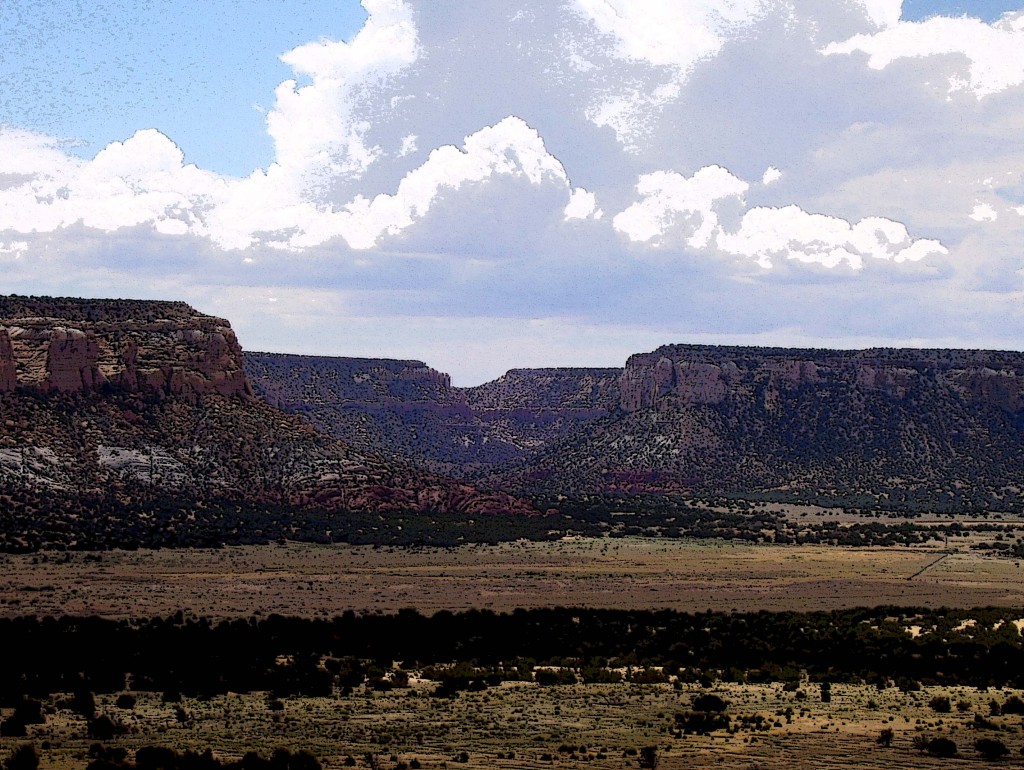
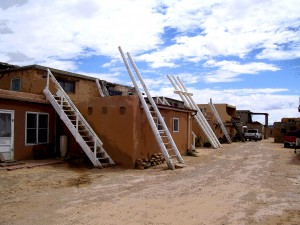
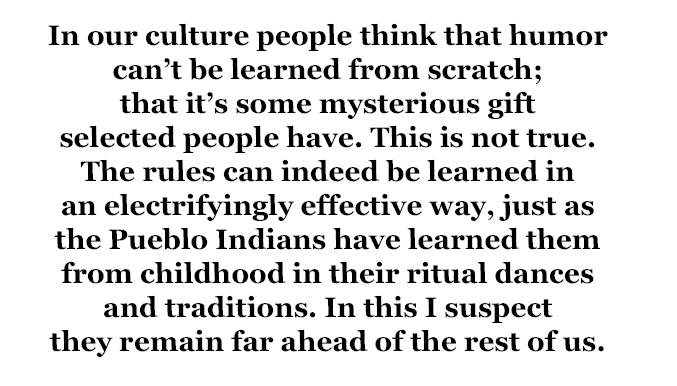
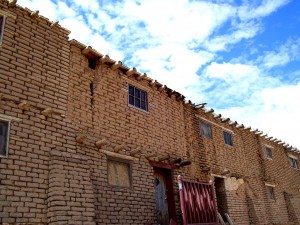
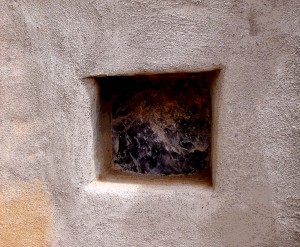
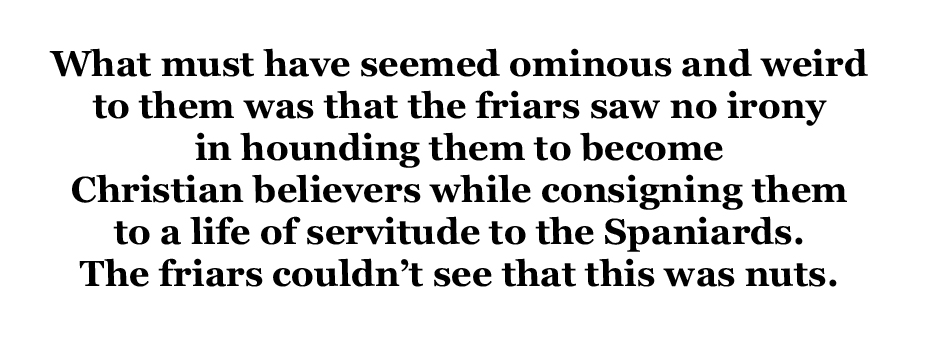
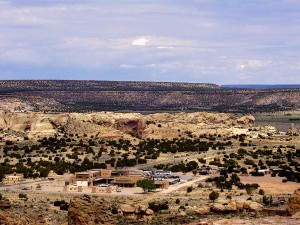


With US politics the way it is the public needs a sense of humor to survive. When I hear the words “TeaParty” I picture a group of people running around like the Mad Hatter, more sure of where they are more sure of where they are not going than they are of what is ahead in the direction they are going. Watching a presidential candidate who probably still have a nanny that wipes his butt try to connect wih ordinary people isn’t half as funny as that of the ordinary people who believe he can save them from the guy who is trying to save their homes, create jobs for them and give them decent affordable health care. Yeah, but his hew is wrong.
In writing this story on sacred humor I failed to mention Ned Mudd’s oustanding satire on the subject of global warming.
My bad.
Comedians such as Jon Stewart and Lewis Black could learn a great deal from Ned about what to say and do on this subject.